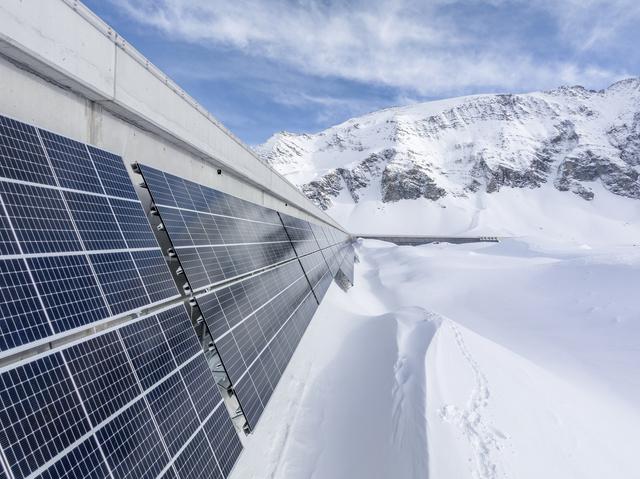30.07.2025 | Severely damaged Grono power plant owned by Elettricità Industriale SA (ELIN) partially back online after 320 days
Devastating damage – complex repairs
ELIN's power plants in Misox were severely damaged by a storm. How can they be brought back online as quickly as possible? With dedication, expertise, teamwork – and around 20 experts from the Engineering business unit of the Hydro & Biomass Division of Axpo.
It was short, violent and devastating. In June 2024, a storm of rare intensity raged through the Misox valley in southern Graubünden. Up to 75 litres of rain fell per square metre in just one hour. The consequences: two fatalities, one person missing – and widespread destruction of infrastructure.
Six Axpo hydropower plants were also affected: severely damaged water intakes, flooded power plant sites, blocked access roads and a displaced pressure pipe. By far the hardest hit was the Grono plant of Elettricità Industriale SA (ELIN) with the Roggiasca dam, the Grono power station and several water intakes. Or, as Felix Hansmann puts it: ‘It was almost a total write-off.’ As Head of Structural Maintenance in the Engineering department of the Hydro & Biomass Division, he is responsible for the clearance and repair work on the damaged Misox power plants as overall project manager. Employees from the Misox power plant group were also responsible for providing support on site.
The damage to the Grono plant was devastating. The water intakes? Partially destroyed, covered with debris and tree trunks. The Roggiasca reservoir? Covered with tree trunks over a large area. And the lake bed filled with metres of debris. The bottom outlet? Covered with sediment and blocked up to a height of around 10 metres. The almost four-kilometre-long pressure tunnel from the reservoir to the water tower? Covered with over a metre of mud along its entire length. The pressure tunnel to the Grono power station? Filled with around 120 cubic metres of debris. The ball valve in the Grono power station? Blocked by pieces of wood. In addition, there was a lot of minor damage to various parts of the plant. Continuing to operate the power station was out of the question.
How do you deal with such extensive damage? Where do you start? ‘First, we needed as accurate an overview of all the damage as possible,’ says Felix Hansmann. Easier said than done. The access roads and hiking trails were damaged or blocked after the storm, and it first had to be ensured that there were no further natural hazards (water, rockfall, instability) threatening any of the structures. ‘Secondly, we needed comprehensive plans on how to safely tackle the repair work.’ As virtually all parts of the plant were affected, this required extensive specialist knowledge. ‘Fortunately, we were able to plan and carry out most of the work with internal resources,’ explains Felix Hansmann. The list of Axpo departments that have been involved over the past 12 months is indeed long: project and construction management, construction, dams, geology/natural hazards, environment, surveying, steel hydraulic engineering, design, mechanics, electrical engineering, insurance and more. ‘All in all, around 20 specialists and experts from Axpo were involved.’ In addition, there was a major effort by the operating personnel on site at the Misox power plant group and around five other external employees (natural hazards and local construction management).
They had their hands full over the past twelve months. Over 200 tonnes of tree trunks were removed from the Roggiasca reservoir with the aid of pontoons and cranes. The reservoir was then completely emptied by flushing in accordance with a detailed plan and accompanied by precise monitoring. This was the only way for the employees to remove the approximately 40,000 cubic metres of sediment from the bottom of the lake and thus expose the bottom outlet and the intake structure for the water. The pressure tunnel had to be cleared in painstaking detail and then flushed in a second phase. The damaged water inlets were located in difficult terrain, making their clearance and repair particularly challenging. ‘The teamwork was outstanding. Within Axpo, we benefited from a wealth of expertise and short communication channels,’ concludes Hansmann.
At the Grono stage, two of the three turbines at the Grono power station are back in operation since the beginning of May 2025 after an outage of around 320 days. The third is scheduled to follow by the end of the year. The Lostallo stage, where a pressure pipe was displaced by the storm, was back in operation after just 39 days. The enormous effort involved in the repairs also comes with a price tag: the renovation cost around CHF 8 million, around two-thirds of which is covered by insurance. Added to this are the production losses, only a small portion of which are covered by insurance. Nevertheless, thanks to its large power plant fleet, Axpo was able to compensate for this loss relatively well.
Axpo: A leader in hydropower
- Axpo currently operates 60 hydropower plants with a total turbine output of almost 4,000 MW, making it Switzerland's largest hydropower producer.
- Axpo has been building and operating hydropower plants for over 100 years and therefore has immense expertise in this field.
- Including its shareholdings, Axpo is responsible for 11 TWh of electricity from hydropower each year, which corresponds to almost a third of the energy produced from hydropower in Switzerland.
- Axpo employs around 550 people in the operation, maintenance, renewal and management of hydropower plants, 120 of whom work in hydropower-specific engineering.
- Thanks to its large hydroelectric power plant with over 150 machine sets (generator with turbine) and 45 dams, Axpo has many highly qualified specialists in all specific areas of hydroelectric power. This enables Axpo to master even demanding challenges in the operation and maintenance of hydroelectric power plants efficiently and in a cost-optimised manner.
- Axpo was the first hydropower company in Switzerland to recognise the huge potential of digitalisation and subsequently built Switzerland's first digital hydropower plant. Axpo continues to lead the way in the development and application of digital tools for optimised hydropower plant operation.
More information about Axpo Hydropower is available here.





